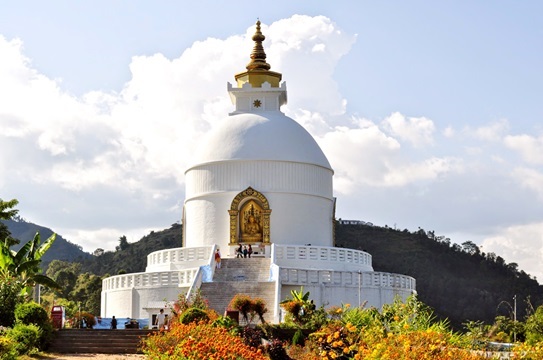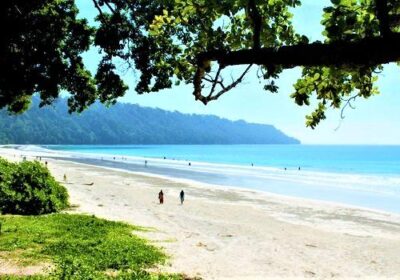Peace Pagoda: A Symbol of Harmony and Spiritual Tranquility in Darjeeling
The Peace Pagoda in Darjeeling, a serene and striking landmark, stands as a testament to universal harmony and the promotion of peace. Built under the guidance of Nichidatsu Fujii, a Japanese Buddhist monk and founder of the Nipponzan-Myōhōji Buddhist Order, this pagoda is one of the many Peace Pagodas around the world designed to inspire global unity.
Historical Background
The Peace Pagoda in Darjeeling was constructed between 1972 and 1992, with the objective of creating a sanctuary of peace and a symbol of unity among different races and religions. Nichidatsu Fujii’s vision was to spread the message of non-violence and harmony, following the teachings of Lord Buddha. The pagoda was inaugurated on November 1, 1992, and since then, it has been a significant spiritual and tourist attraction in Darjeeling.
Architectural Features
- Design and Structure: The Peace Pagoda, designed by Nichidatsu Fujii, reflects traditional Japanese architecture. The white structure, standing at a height of 28.5 meters (94 feet), is topped with a golden spire, which adds to its majestic appearance. The pagoda is surrounded by lush greenery, providing a peaceful and serene environment.
- Buddha Statues: The pagoda houses four golden statues of Buddha, each representing different stages of Buddha’s life—birth, enlightenment, teaching, and death. These statues are intricately crafted and exude a sense of calm and spiritual tranquility.
- Murals and Carvings: The walls of the pagoda are adorned with beautiful murals and carvings depicting various events from Buddha’s life. These artworks not only enhance the aesthetic appeal of the pagoda but also provide insights into the teachings and life of Buddha.
Spiritual Significance
- Promoting Peace and Unity: The primary objective of the Peace Pagoda is to promote peace and unity among people of different backgrounds. It serves as a reminder of the importance of non-violence and harmony in today’s world.
- Meditation and Prayer: The pagoda is a popular site for meditation and prayer. The serene environment and the presence of Buddha statues create an ideal setting for introspection and spiritual practice. Visitors often come here to meditate, seeking inner peace and spiritual solace.
- Cultural Integration: The Peace Pagoda represents the integration of different cultures and religions. It stands as a symbol of how diverse traditions can coexist harmoniously, fostering mutual respect and understanding.
Visitor Experience
- Reaching the Pagoda: The Peace Pagoda is located on the slopes of Jalapahar Hill in Darjeeling. Visitors can reach the pagoda by a short drive or a leisurely walk through the scenic trails. The journey to the pagoda is filled with lush greenery and offers stunning views of the surrounding hills.
- Exploring the Pagoda: Upon reaching the Peace Pagoda, visitors are greeted with the tranquil ambiance and the stunning architecture of the structure. The serene environment provides a perfect setting for relaxation and contemplation.
- Views of the Himalayas: The location of the Peace Pagoda offers panoramic views of the Himalayan range, including the majestic Kanchenjunga. The breathtaking vistas add to the overall experience, making it a memorable visit.
- Interacting with Monks: The Nipponzan-Myōhōji temple, situated adjacent to the pagoda, is home to monks who are often seen chanting and praying. Visitors can interact with the monks, gaining insights into their way of life and the teachings of Buddhism.
- Photography: The Peace Pagoda, with its striking architecture and serene surroundings, is a paradise for photographers. The golden statues, intricate carvings, and panoramic views offer numerous opportunities for capturing stunning images.
Best Time to Visit
The Peace Pagoda can be visited throughout the year. However, the months of October to December and March to May are considered the best times to visit, as the weather is pleasant and the skies are clear, providing optimal conditions for enjoying the views and exploring the surroundings.
Accessibility and Visitor Information
- Location: The Peace Pagoda is situated on Jalapahar Hill, approximately 2.5 kilometers from Darjeeling town center.
- Timings: The pagoda is open to visitors from 4:30 AM to 7:00 PM daily. It is advisable to visit early in the morning or late in the afternoon to avoid crowds.
- Entry Fee: There is no entry fee to visit the Peace Pagoda.
- Tips:
- Wear comfortable walking shoes if you plan to hike up to the pagoda.
- Carry a camera to capture the beautiful scenery and the architecture of the pagoda.
- Respect the sanctity of the place by maintaining silence and following the rules.
Conclusion
The Peace Pagoda in Darjeeling is not just an architectural marvel but also a beacon of spiritual and cultural unity. Its serene environment, combined with its historical and spiritual significance, makes it a must-visit destination for anyone traveling to Darjeeling. Whether you are seeking peace, spirituality, or simply want to experience the beauty of the Himalayas, the Peace Pagoda offers a unique and enriching experience.






Leave feedback about this